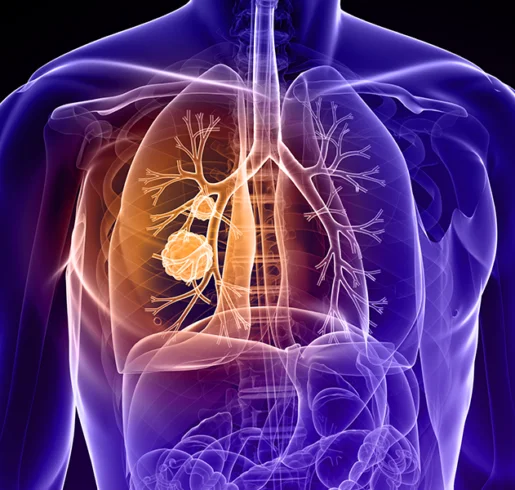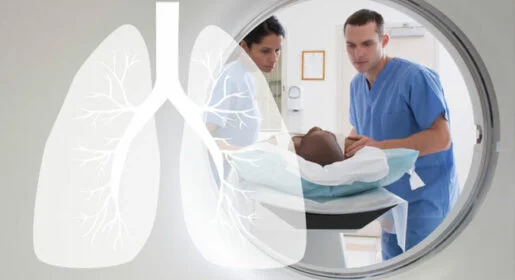Lung Cancer Treatment In India With Highest Success Rate
Are you confused about your treatment decision regarding your early-stage lung cancer?
Although many advanced technologies are there to treat lung cancer, only reputed hospitals and efficient surgeons can apply those technologies correctly.
But you would need advanced technology and specialists under your budget to get the best medical care and treat cancer successfully.
Lung cancer treatment in India can help you fulfil your dream of living cancer-free.
So, without further ado, let us learn about lung cancer and how coming to India can help you be treated.

What is Lung Cancer?
Cancers of the lungs arise from irregular cell formations in lung tissue that multiply beyond normal rates. They can be specialized to attack neighbouring tissues or to form tumors. As another type of cancer, lung cancer can occur in any area of the lungs and different parts of the respiratory tract.
Well, before we proceed, let’s identify different forms of lung cancers:

What are the Different Stages of Lung Cancer?
Currently, the stages of Lung Cancer are divided into five; however, it is also worth understanding the earlier staging that includes stages 0, I, II, III and IV.
The stage of cancer indicates where the cancer is situated with other organs, its size and how it has progressed to other factions of the lungs or other organs if it is lung cancer.
Physicians going through the layer of mucous membrane of respiratory system are likely to identify existing strange cells. This type can be cancerous but are not invasive, and has no connection with other parts of the body.
The cases in stage 1 are categorized into two sub-types:
- Stage 1A: Cancer of the lung refers to a tumor of 3 cm or less in a dimension that has not reached the nodes or any other organ of the body.
- Stage 1B: Sometimes the lung cancer tumor is bigger than 3 centimetres but not more than 4 centimetres, and it does not involve the lymph nodes. The cancer did not spread to the nearby lymph nodes.
The cases in stage 2 are categorized into two sub-types:
- Stage 2A: The lung cancer tumor is less than 5 cm, but greater than 4 cm, and did not metastasize the lymph nodes. Lungs have collapsed or are pneumonic.
- Stage 2B: In some cases, the lung cancer tumor is 5 cm or smaller and has reached the lymph nodes situated in the same region of the chest as the original tumor.
There are three sub-types of stage 3 non-small cell lung cancer:
- Stage 3A: The tumor is less than 5 cm and reaches the lymph nodes in the same area of the chest where the primary tumor was detected. Lung cancer is of any size and has reached the trachea, or esophagus, among other parts of the body.
- Stage 3B: The tumor is five cm or less, and the carcinoma has reached the lymph node above the collarbone in the same area of the chest.
- Stage 3C: The tumor is of any size and the lymph nodes have been affected to the same or opposite side of the chest.
Stage 4 non-small cell lung cancer cases are categorized according to two subtypes:
- Stage 4A: One has to agree that at least one tumor is present in a lung that is opposite to the place where it seems to originate in the human body. Cancer affects the sac around the heart of the tissue surrounding the lungs known as mesothelium.
- Stage 4B: This means that cancer has progressed to different parts of at least a distant organ of the lung.
What are the Common Approaches of Doctors to Treat Different Stages of Lung Cancer?
Once your doctor confirms lung cancer the first thing that you think is the treatment for it. But before confirming any treatment method you must understand that the treatment varies based on the stage of cancer, location, and extent of spread of cancer.
Based on the stage of cancer the different approaches for lung cancer treatment in India are:
Your doctor may advise surgery to remove the cancer cells from your lungs and adjacent lymph nodes. Generally, doctors advise chemotherapy after the surgery to ensure that you are cancer-free.
The treatment of stage 2 lung cancer is very similar to the treatment of stage 1 lung cancer. However, sometimes your doctor may suggest chemotherapy or radiation therapy to shrink the cancer before the surgery.
For treating stage 3 lung cancer your doctor may suggest surgery followed by chemotherapy and immunotherapy.
Sometimes your doctor may advise targeted therapy for you.
It is difficult to reverse advanced lung cancer. However, your doctor may advise you on some medicines to manage the symptoms.
Frequently Asked Questions (FAQs)
Q1. Which is the best treatment for lung cancer?
For lung cancer, the treatment that should be provided depends on the stage of cancer the patient is in.
Treatments that may be used in advanced lung cancers include radiotherapy which can alleviate pain.
Q2. How many chemotherapy sessions does it take for lung cancer treatment in India?
Most people need four to six cycles of treatment in three to six months. You will meet with your physician at the end of these cycles. If the cancer is better, you may not need chemotherapy anymore. If cancer has not improved after these cycles, your doctor will let you know if you require a different type of chemotherapy.
Q3. Does chemotherapy cure lung cancer?
In lung cancer, the treatment varies according to the general condition of the patient. That is, if you are in good general health, the chemotherapy, chemotherapy plus radiotherapy (chemoradiotherapy) can help you. Some patients even get cured because of this treatment.
Q4. Is four rounds of chemotherapy a lot?
In the course of treatment, you usually have about 4 to 8 cycles of treatment. A cycle is a time between one cycle of treatment and the start of the next. After each treatment cycle, you have a break so that your body can recover.
Q5. Why does lung cancer develop?
Lung cancer happens when cells in the lung grow out of control. This change, a steady shift in the gene’s DNA, can come from many causes. Such shifts in lung cells often happen when you breathe in toxic air, poisons, or other risky substances.
Q6. Is lung cancer curable? How is it treated?
For stage 1 non-small lung cancer patients, the common treatment offered would be surgery to remove the tumor. In Small-cell lung cancer, chemotherapy and radiation therapy are used. Immunotherapy and targeted therapy have also brought significant changes in lung cancer treatment modalities.
Q7. Is it possible to be completely cured of lung cancer?
Lung cancer’s cure is still possible if diagnosed in the early stages when confined to the lung. If your lung cancer spreads outside your lung, it is not considered curable.
Q8. What methods can be used for self-detection of lung cancer?
There are home tests that can be used as preliminary cancer screenings for certain forms of cancer, including colon cancer but a similar opportunity for screening for lung cancer is not available. The only way to prescribe tests to diagnose lung cancer is through a doctor.
Q9. Can lung cancer be cured at the final stage?
Stage 4 lung cancer is the most advanced stage. While the 5-year relative survival rate is very low, it isn’t necessarily the end. There are no current treatments that can cure stage 4 NSCLC. However, treatments may help reduce your symptoms and ease your quality of life.
Q10. What is the role of palliative care in lung cancer treatment?
Palliative care is specialized care that only focuses on quality of life. You can receive this type of care at any point during your lung cancer journey. Palliative care may benefit you by helping to relieve pain and other symptoms that come from lung cancer.
Q11. Can lung cancer be treated with a combination of therapies?
Research done on patients undergoing combination therapy in the treatment of lung cancer shows a higher overall survival rate. Scientists learned that when more than one drug is used in the treatment of a cancer patient the probability that all cancer cells will be destroyed is increased.
Q12. Are there any clinical trials available for lung cancer treatment?
Lung cancer clinical trials in India provide the opportunity to receive the latest and most advanced cancer treatments free of cost. Lung cancer immunotherapy and targeted therapy are available.
Q13. What is the prognosis for lung cancer patients?
The 5-year survival rate for localized lung cancer is 65%, for regionally spread lung cancer is 37%, and for cancer which has spread to distant sites is 9%.
Q14. Does the type of lung cancer affect the treatment approach?
There are two primary types of lung cancer- Non-Small Cell Lung Cancer-NSCLC and Small Cell Lung Cancer-SCLC. NSCLC (but not all) can be further sub-typed. Depending on what type or sub-type of lung cancer you have, treatment may differ.
Q15. Is immunotherapy available for lung cancer treatment in India?
Yes, immunotherapy is available for lung cancer treatment in India at leading hospitals, helping improve survival rates for patients with advanced-stage cancer.
Q16. Is lung cancer treatment in India affordable?
A. Yes, India offers high-quality cancer care at a fraction of the cost compared to many Western countries, making it a preferred destination for medical tourists.
Q17. Can international patients get lung cancer treatment in India?
A. Yes, many Indian hospitals have dedicated international patient departments to assist with visas, travel, accommodation, and personalized care.
Q18. How can I book a consultation with MedicoExperts for lung cancer treatment in India?
A. You can simply visit www.medicoexperts.com or contact our medical team directly via WhatsApp or phone. We’ll guide you with a free initial opinion and end-to-end assistance throughout your treatment journey.
- https://www.ncbi.nlm.nih.gov/books/NBK534863/
- https://www.ncbi.nlm.nih.gov/pmc/articles/PMC4062211/
- https://www.ncbi.nlm.nih.gov/books/NBK564400/
- https://www.ncbi.nlm.nih.gov/pmc/articles/PMC10636456/
- https://www.ncbi.nlm.nih.gov/pmc/articles/PMC10569391/
- https://vats.amegroups.org/article/view/8637/html
- https://www.ncbi.nlm.nih.gov/pmc/articles/PMC4990666/
- https://www.ncbi.nlm.nih.gov/books/NBK532952/
- https://www.ncbi.nlm.nih.gov/books/NBK553123/
- https://www.ncbi.nlm.nih.gov/books/NBK555969/
- https://www.ncbi.nlm.nih.gov/books/NBK567722/
- https://www.ncbi.nlm.nih.gov/pmc/articles/PMC7778637/
Next in Lung Cancer

Author Bio:
Dr. Yashashree Joshi – MBBS, MD (Philippines)
Dr. Yashashree Joshi, MD, is a globally-trained oncologist with a robust academic background and extensive experience in pioneering cancer treatments. Dedicated to patient-centered care, she continually integrates the latest advancements in oncology to provide her patients with innovative and personalized treatment plans.
Content Medically Reviewed By MedicoExperts Editorial & Clinically Review Board




